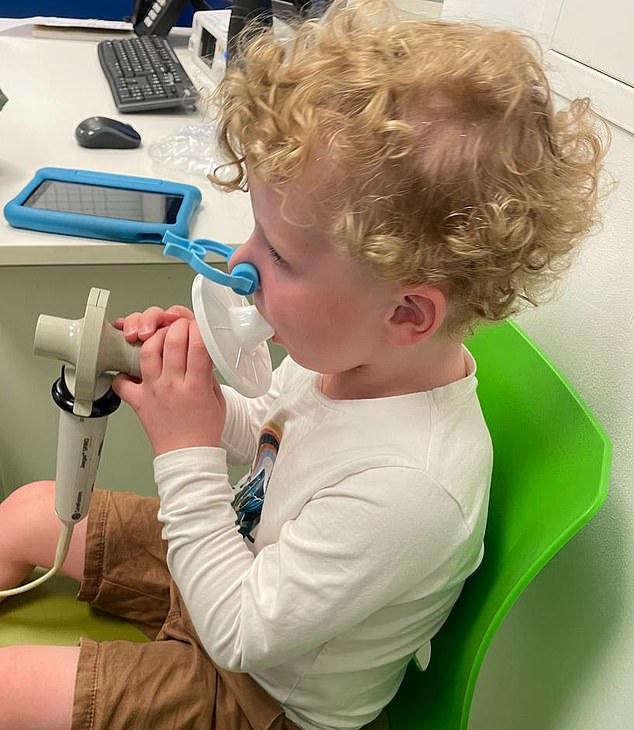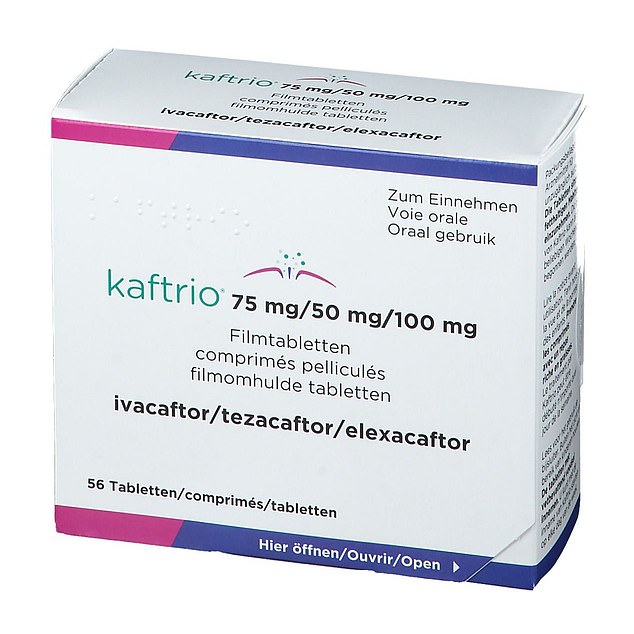‘Miracle’ cystic fibrosis medicine gets approved for toddlers, sparking hope for hundreds of ‘terrified’ parents who feared their kids would never get £200k drug shown to extend life by up to 30 years
A ‘miracle drug’ for cystic fibrosis was approved today for toddlers battling the cruel disease, bringing hope to hundreds of parents.
Until now, health chiefs had only approved Kaftrio for children over the age of six.
But the Medicines and Healthcare products Regulatory Agency (MHRA) today gave the drug – believed to cost around £200,000 a year – the green light for young people aged two and over.
Studies have shown that it can extend the life expectancy of patients by 30 years.
However, NHS watchdogs are currently considering rejecting the drug for widespread use across the NHS due to its costs.
Nikki Thorbinson (right) hoped to have her five-year-old son Henry Kaftrio for Christmas

Henry, pictured, must attend numerous appointments every day, taking medication, having scans, x-rays and physiotherapy to stay healthy
In draft guidelines last week, the National Institute for Health and Care Excellence (NICE) said Kaftrio should not be recommended despite its clear benefits.
Only children who are already using Kaftrio will be allowed to continue using it if NICE does not change its mind in the coming months.
Under the MHRA’s old two-tier licensing system, parents of toddlers battling cystic fibrosis feared they would never benefit from the drug.
It is now expected that hundreds of families with children aged two to five years will come forward to receive the drug before supplies may be stopped.
It is estimated that up to 600 children could benefit from the deal.
Ahead of today’s decision to license Kaftrio for younger children, affected families told MailOnline they were terrified their children would be denied the chance to get the drug because of their age.
Nikki Thorbinson, whose five-year-old son Henry has cystic fibrosis, was “desperate” and “clinging to a ray of hope” that it would eventually become available.
She said: ‘This drug has been talked about by our teams for the last five years.
‘It gives hope for a normal life, free from the burden of therapies, that Henry puts a smile on his face every day.’
Giving Henry the drug would mean “he has a future to thrive,” she said.
Kaftrio is currently only available on the NHS through a temporary agreement with London-based manufacturer Vertex Pharmaceuticals.
Pharmaceutical bosses agreed to cut their price for the deal, which expires in August 2024. The exact amount has not been shared publicly.
Despite Kaftrio being offered slightly cheaper than its stated price tag, NICE announced the ‘triple combination therapy’ last week and two others (Symkevi and Orkambi) were not ‘cost-effective’.
NICE’s draft guidelines found that the cost-benefit ratio was higher than what was considered ‘an acceptable use of NHS resources’.
A final ruling is expected in March 2024, with committee members meeting next month to further discuss the evidence.
John Stewart, national director for specialist commissioning at NHS England, said: ‘Children aged two years and over with cystic fibrosis are now eligible for Kaftrio.
‘Cystic fibrosis centers across the country have plans in place to ensure that all children currently eligible can have long-term access to this life-changing treatment.’
If NICE officially rejects Kaftrio, it will mean that anyone not already using the drug will not be eligible to get it on the NHS.

It is hoped that the drug Kaftrio, pictured, is a triple therapy – combining three compounds, ivacaftor, tezacaftor and elexacaftor – will add decades to the lives of people with cystic fibrosis.
The Cystic Fibrosis Trust hopes that ‘everyone will take action as soon as possible to ensure that eligible children can receive Kaftrio quickly’.
David Ramsden, director of the charity, said: ‘This is great news and another important step in ensuring access to life-changing modulator drugs for everyone with cystic fibrosis who could benefit.
‘I am also reassured that NHS England has confirmed that all children eligible today can have confidence in their long-term access to these treatments.
‘Today’s news reinforces the need to ensure that the current NICE process quickly results in a comprehensive deal to end uncertainty for all who could benefit from it in the future.’
Cystic fibrosis – which affects 11,000 people in the UK – is usually detected at birth using a newborn heel prick test.
It is caused by a defective gene that a child inherits from both parents, making it difficult for cells to move water and salt in and out of the cells.
As a result, the body produces thick, sticky mucus that clogs the digestive system, causing problems with food absorption, and the lungs, resulting in infections and scarring that gradually reduce the patient’s ability to breathe.
This slow suffocation is often what is ultimately fatal.
Advances in treatment over the past forty years have increased life expectancy. As recently as the 1970s, few people with cystic fibrosis lived beyond their teenage years.
Kaftrio corrects the underlying problem by helping to produce thinner mucus, thus relieving symptoms.
Experts are hopeful that the triple therapy – which combines ivacaftor, tezacaftor and elexacaftor – will add decades to the lives of people with cystic fibrosis.
